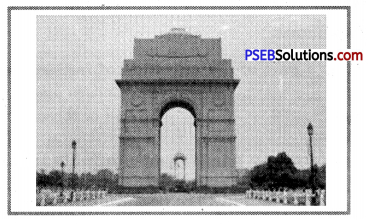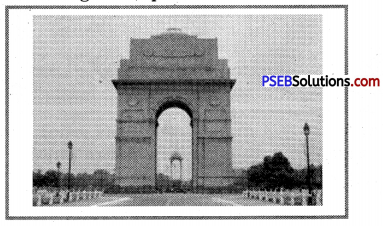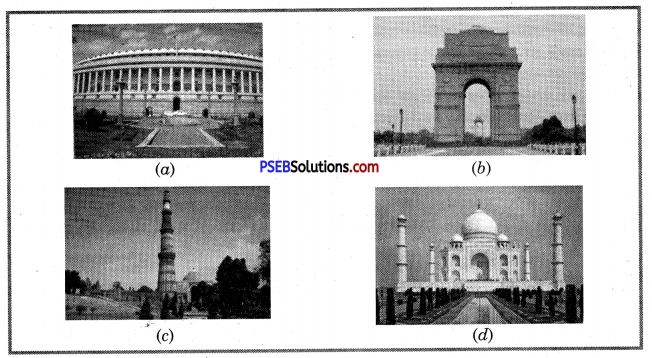Punjab State Board PSEB 8th Class Social Science Book Solutions History Chapter 9 When, Where and How Textbook Exercise Questions and Answers.
PSEB Solutions for Class 8 Social Science History Chapter 9 When, Where and How
SST Guide for Class 8 PSEB When, Where and How Textbook Questions and Answers
I. Write down the answer of the following questions:
Question 1.
In which three periods the Historians have divided the Indian History?
Answer:
Historians have divided the Indian History in three periods and these are:
(a) Ancient period
(b) Medieval period
(c) Modern period.
Question 2.
When modern period started in India?
Answer:
It has been considered that modern period, in India, was started in 18th century after the death of Aurangzeb.
Question 3.
When independent state of Hyderabad was founded and who founded it?
Answer:
Independent state of Hyderabad was founded by Nizam-ul-Mulk in 1724 A.D.
![]()
Question 4.
Write down the names of the European powers who came to India during the modern period.
Answer:
Portuguese, Dutch, French and the British.
Question 5.
When and by whom the independent state of Avadh was founded?
Answer:
Avadh was declared as an independent state by Saadat Khan in 1739 A.D.
Question 6.
How books as historical sources help us?
Answer:
A number of books were printed in modern age in English and in Indian languages due to the invention of printing press. With these books, we come to know about human development in different fields such as literature, art, history, science and music. These books are very helpful in increasing our knowledge about history and science. We can take inspiration from these books to do progress in our lives.
Question 7.
Write down in brief about the historical buildings.
Answer:
Historical monuments, built in the modern age, are the living examples of History. A number of historical monuments still exist is our country and still are in very good condition. India Gate, Parliament House, President House, Birla House and other buildings are included in it. These monuments tell us about different aspects of Indian art and architecture.
![]()
Question 8.
How Newspapers, Magazines and Pamphlets are helpful in writing history?
Answer:
A number of newspapers, magazines and pamphlets, in different Indian languages, were printed in modern age in India. Out of them ‘The Tribune’, ‘The Times of India’ and many other newspapers are still printing. Ah these newspapers and magazines give us information of many important events of modern age. Even they print any particular news of that age in today’s newspaper. In this way they are helpful in writing history.
Question 9.
Write a note on Govt. Documents.
Answer:
Government documents are a very important source of history of modern India. We can get information about activities of foreign powers, the British conquest of India and the British administration in India through these documents. These documents also tell us that how India was economically exploited by the British. In other words Government documents are one of the important sources of writing history of modern India.
II. Fill in the Blanks:
Question 1.
In Europe Modern Period began in the __________ century.
Answer:
16th
Question 2.
There was __________ period in India in the 16th century.
Answer:
medieval
Question 3.
__________, __________, __________ Pathans and Rajputs etc. new powers emerged in the 18th century.
Answer:
Marathas, Sikhs, Rohillas
![]()
Question 4.
In 1724 A.D., Nizam-Ul-Mulk founded an independent state of __________
Answer:
Hyderabad
Question 5.
In 1739 A.D., Sadaat Khan made an independent state.
Answer:
Avadh
Question 6.
Three carnatic curves were fought between the and Britishers during the period 1744 to 1763 A.D. which British got victorious?
Answer:
French
Question 7.
__________, newspapers, magazines, pamphlets and historical buildings are main sources of Modern Indian History.
Answer:
Books, government documents.
III. Write True or ‘False’ in the brackets given after each statement:
Question 1.
There were many social evils prevalent in India in the 18th century.
Answer:
True
![]()
Question 2.
Western ideas enlightened the Indians along with western education and literature.
Answer:
True
Question 3.
In India Mughal Empire was more powerful in the 18th century.
Answer:
False
IV. Something To Do:
Question 1.
Write main sources of Modern Indian history on a chart with a picture of each source and paste it on the wall of your class room.
Answer:
Do it yourself with the help of your teacher.
PSEB 8th Class Social Science Guide When, Where and How Important Questions and Answers
Multiple Choice Questions:
Question 1.
Which of these is a part of periodization of Indian history?
(a) Ancient age
(b) Modern age
(c) Medieval age
(d) All of these.
Answer:
(d) All of these.
![]()
Question 2.
Which of these European powers came to India in modern age?
(a) British
(b) Dutch
(c) French
(d) All of these.
Answer:
(d) All of these.
Question 3.
Who among the following was the first Governor-General of India?
(a) Lord Dalhousie
(b) Warren Hastings
(c) Lord Wellesley
(d) Lord Canning.
Answer:
(b) Warren Hastings.
Question 4.
Which of these is a source of history of modern India?
(a) Books
(b) Historical Monuments
(c) Official Documents
(d) All of these.
Answer:
(d) All of these.
Question 5.
Who founded the independent state of Awadh?
(a) Nizam-ul-mulk
(b) Ali Vardi Khan
(c) Tipu Sultan
(d) Murshid Quli Khan.
Answer:
(a) Nizam-ul-mulk.
![]()
Question 6.
Identify the following pictures and tell with which period do these buildings belong?

(a) Ancient period
(b) Gupta Period
(c) Medieval period
(d) Modern period.
Answer:
(d) Modern period.
Question 7.
__________ Carnatic wars were fought between the French and the British.
(a) Two
(b) Three
(c) Four
(d) Five.
Answer:
(c) Four.
Question 8.
__________ period began in the 16th century in Europe.
(a) Medieval
(b) Modern
(c) Gupta
(d) Ancient.
Answer:
(b) Modern.
![]()
Question 9.
The given picture is of one of the famous historical building in India. Name the building.

(a) India Gate
(b) Qutub Minar
(c) President House
(d) None of these.
Answer:
(a) India Gate.
Question 10.
With which age the buildings given below are associated?

(a) Modern age
(b) Ancient age
(c) Medieval age
(d) None of these.
Answer:
(a) Modern age.
Question 11.
Identify the building in the picture.

(a) India Gate
(b) Qutub Minar
(e) President House
(d) None of these.
Answer:
(a) India Gate.
![]()
Question 12.
Which building of the following buildings is not situated in Delhi, the Capital of the country?

Answer:
(d) Taj Mahal
Fill in the Blanks:
Question 1.
Modern age in Europe started in __________ century.
Answer:
16th
Question 2.
There was __________ age in 16th century India.
Answer:
medieval
![]()
Question 3.
In 18th century India, many new regional powers puch as____________, __________, __________ Pathan and Rajputs.
Answer:
Marathas, Sikhs, Rohillas.
Tick the Right (✓) or Wrong (✗) Answer:
Question 1.
Many social evils prevailed in Indian society during 18th century.
Answer:
(✓)
Question 2.
Western education and literature along with western ideas motivated Indians against the British.
Answer:
(✓)
![]()
Question 3.
Mughal empire was quite powerful during 18th century.
Answer:
(✗).
Match the Following:
Question 1.
| A | B |
| 1. Saadat Khan | (i) Europeans |
| 2. Nizam-ul-Mulk | (ii) Avadh |
| 3. Babur | (iii) Hyderabad |
| 4. Dutch | (iv) Mughals |
Answer:
| A | B |
| 1. Saadat Khan | (ii) Avadh |
| 2. Nizam-ul-Mulk | (iii) Hyderabad |
| 3. Babur | (iv) Mughals |
| 4. Dutch | (i) Europeans |
Very Short Answer Type Questions
Question 1.
In how many periods, history of the world has been divided?
Answer:
World history has been divided in three periods and these are ancient period, medieval period and modern period.
![]()
Question 2.
In which century, medieval period was started in Europe?
Answer:
In 16th century.
Question 3.
Name any four new powers which emerged on political scene of India in the 18th century.
Answer:
Marathas, Sikhs, Ruhelas and Pathans.
Question 4.
When India became Independent?
Answer:
In 1947 A.D.
Question 5.
Why modern period in Europe started earlier than India?
Answer:
Modern period started very early in Europe, as compared to other countries, which developed very quickly. European countries also progressed very quickly.
Question 6.
Which step was taken by the Indian rulers of modern period to strengthen Indian economy?
Answer:
They gave encouragement to agriculture, trade and industries.
Question 7.
When and between whom were Carnatic wars fought? Who emerged victorious out of these wars?
Answer:
Carnatic wars were fought between the British and the French during the period of 1746-1763 A.D. The British emerged victorious out of these wars.
![]()
Question 8.
On what history is based and how historians reconstruct history?
Answer:
History is based on facts and historians use many sources to reconstruct history.These sources include books, government documents, newspapers, magazines, historical buildings, paintings etc.
Question 9.
Who founded Mysore State and under whom it progressed?
Answer:
Hyder Ali founded Mysore State and it progressed under the son of Hyder Ali, Tipu Sultan.
Short Answer Type Questions
Question 1.
How western education and literature in modern India paved way for Indian independence?
Answer:
A number of schools and colleges were established in the modern period in India where education was given in Indian languages as well as in English language. Western ideas also spread in country through western education and literature. Sense of liberty, equality and fraternity developed among such Indians who received education of philosophy, history and western civilization. They were not able to tolerate the British rule in India and were unable to tolerate the economic exploitation of the country. That’s why they started national movement against the British rule. They gave great sacrifices and suffered a lot and brought freedom for the country in 1947 A.D.
Question 2.
Write a note on the advent of independent states in India in modern period.
Answer:
Many provinces of the Mughal empire took advantage of its weakness and declared themselves independent. First of all Nizam-ul-Mulk founded Hyderabad state in 1724 A.D. After this, Murshid Quli Khan and Alivardi Khan made Bengal a free state. Saadat Khan founded the Avadh state in 1739 A.D. In the same way Hyder Ali founded the state of Mysore in the south. State of Mysore developed to a great deal under Hyder Ah and his son Tipu Sultan. The Marathas also took advantage of this situation. They started to attack Mughal provinces under the leadership of Peshwas.
Long Answer Type Questions
Question 1.
Explain the important sources of history of modern India.
Answer:
History depends upon facts. That’s why historians are dependent upon different sources for the creation of history. A number of sources are there to get information of history of modern India.
Some of these main sources are given below:
1. Books. A number of books were printed in the modern period in English language and in Indian languages due to the invention of printing press. With these books, we came to know about human development in different fields such as literature, art, history, science and music. We can take inspiration from these books to do progress in our lives.
2. Historical Monuments. Historical monuments, built in modern age, are the living examples of history. A number of historical monuments still exist in our country and still are in very good condition. India Gate, Parliament House, President House, Birla House and other buildings are included in it. These monuments tell us about different aspects of art and architecture of India.
3. Newspapers and Magazines. A number of newspapers, magazines and novels, in different Indian languages, were printed in modern age in India. Out of them ‘The Tribune’, “The Times of India’ and many other newpapers are still printing. All these newspapers and magazines give us information of many important events of modern age.
4. Government Documents. Government documents are very important source of the history of modern India. We can get information about the activities of foreign powers, the British conquest of India and the British administration in India through these documents. These documents also tell us that how India was exploited economically by the British.
5. Art and Sculptures. A number of pictures and sculptures are also there which are important sources of modern history. These sources give us information of important historical persons and national leaders.
6. Other Sources. Except given sources, some other important sources of modern Indian history are also there. Most important source out of these sources are films which throw some light on the life and lifestyle of contemporary people. Except this, we can come to know about personality and views of Gandhiji and Pt. Nehru from their own hand written letters and correspondence.
![]()
Question 2.
Write down in detail over “An overview of the modern Indian history.”
Answer:
Modern age in India started in 18th century after the death of Aurangzeb. Some of the features can be seen from the different events of this age and these are given below:
1. Advent of New Powers. Many of the old powers weakened during this age and they were replaced by the new powers. Marathas, Sikhs, Ruhelas, Pathans and Rajputs were emerged as new powers.
2. Arrival of Foreign Powers. Mutual conflict of these Indian powers motivated foreign powers to establish their authority and supremacy in India. Portuguese, the British, Dutch and the French were included among these powers. Modern period in India started with the arrival of European powers.
3. Social and Economic Reforms. A number of social evils were there in Indian society as compared to foreign societies of this time. Many social reformers tried to remove these social evils from society. A number of defects were also there in the economic sector of country. That’s why Indian rulers, i.e. the British, gave special attention to agriculture, trade and industries. They also tried to remove such defects of economy from Indian society.
4. Beginning of National Movement and Independence of country. A sense of liberty, equality and fraternity aroused among those enlightened Indians who got education of history, philosophy and western civilization. They were not able to tolerate the British rule in India and were unable to tolerate economic exploitation of the country. That’s why they started national movement against the British rule. They gave many sacrifices and suffered a lot and brought freedom for the country in 1947 A.D.
5. Reorganization of Economy. Work of reorganization of the economy of country started after the achievement of independence. That’s why just within 69 years of freedom, Indian economy has been emerged as one of the fastest growing economy of the world.
Question 3.
Explain the main developments during modern period of Indian history.
Answer:
The age of 18th century or the beginning of modern age of Indian history is known as the Black age. It was so because country was weakened due to the decline of Mughal Empire. Conflict between local powers and foreign powers started in the country.
The advent of Independent States. Many small states or different provinces of the Mughal Empire took advantage of its weakness and declared themselves independent.
- First of all, Nizam-ul-Mulk founded the independent state of Hyderabad in 1-724 A.D.
- After this, Bengal was made an independent state by Murshid Quli Khan and Alivardi Khan.
- Saadat Khan made an independent state of Avadh in 1739 A.D.
- In the same way, Mysore state was founded in the South under the leadership of Hyder Ah.
- The state of Mysore was greatly developed under the leadership of Hyder Ali and his son Tipu Sultan.
- Marathas also took advantage of this situation and started invading Mughal states under the leadership of Peshwas.
Struggle among the Foreign Powers. European powers such as the Portuguese, Dutch, French, and British also took advantage of the weakness of Mughals and tried to establish their rule in the country. Three Carnatic wars were fought between the British and the French during 1746-1763 A.D. The British emerged victorious which paved the way for the establishment of British rule in India.
The British control over the Indian Economy. The Indian economy was severely damaged by the chaos which prevailed in the Indian politics of that time. The British took control of Indian trade. Handicraft work and artisan work both were destroyed by the British policies.